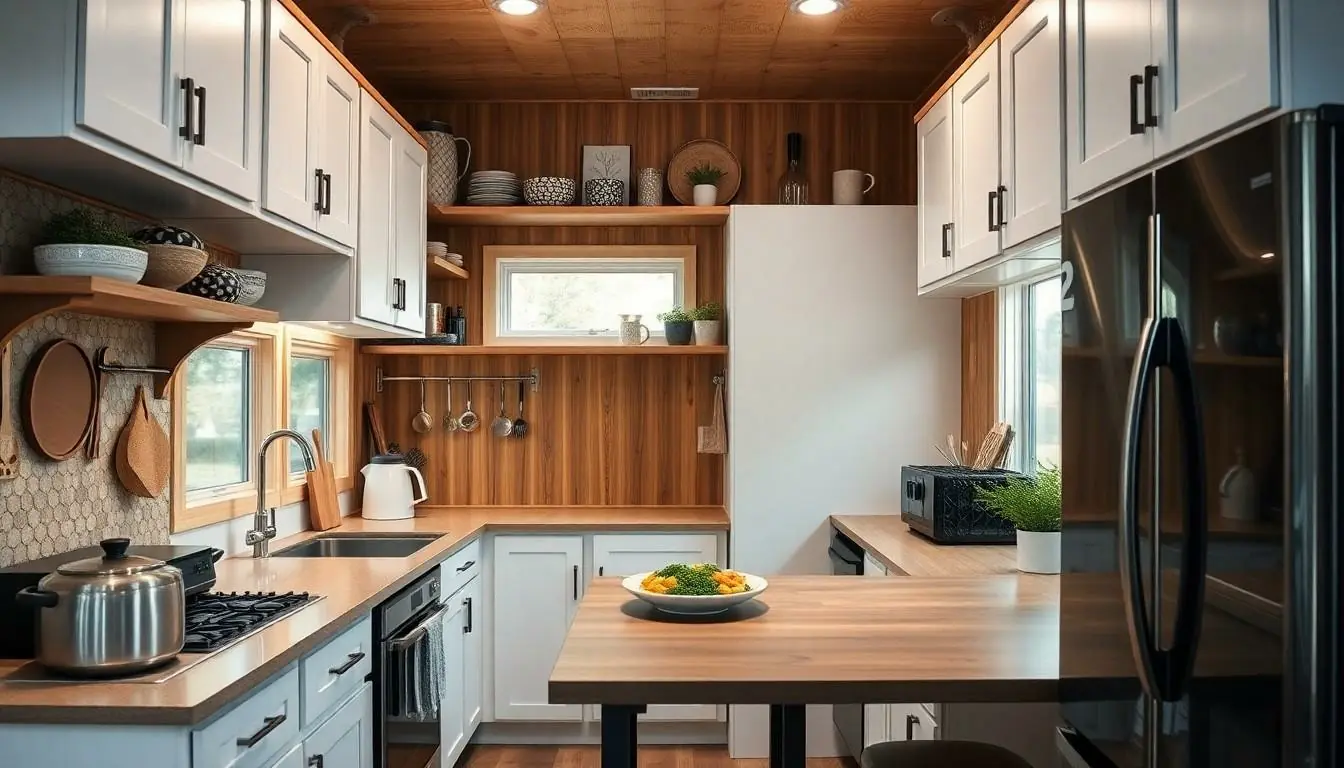Table of Contents
ToggleIn a world where bigger often seems better, tiny house kitchens are flipping the script. These pint-sized culinary havens pack a powerful punch, proving that size doesn’t always matter. With clever designs and multifunctional furniture, they inspire creativity while making the most of limited space. Who knew whipping up a gourmet meal could feel like a high-stakes cooking show challenge?
Overview of Tiny House Kitchens
Tiny house kitchens exemplify creativity in compact living. Limited space prompts innovative design choices that prioritize practicality. Full functionality often simplifies the cooking process, allowing for a streamlined culinary experience.
Many tiny house kitchens incorporate multifunctional furniture, such as foldable tables and expandable countertops. These features maximize available square footage while providing essential cooking and dining areas. Storage solutions also receive special attention, utilizing vertical cabinets and under-counter spaces for optimal organization.
Compact appliances play a crucial role in these kitchens. Dishwashers, ovens, and refrigerators are often smaller, yet maintain efficiency. Design choices can enhance workflow, with each element carefully positioned to allow for easy movement.
Natural light enhances the ambiance in tiny kitchens, making them feel more spacious. Windows and skylights, frequently included, connect indoors to the outdoors. Bright colors and light materials can further create an illusion of a larger area.
Different designs appeal to diverse lifestyles. Some may prefer sleek, modern aesthetics, while others might gravitate toward rustic charm. Choices often reflect an individual’s personality and cooking habits.
Small yet effective, tiny house kitchens stand as a testament to designing within limitations. They embody the principle that effective layouts and thoughtful design elevate even the smallest of spaces. Cooking in these kitchens often captures the joy and adventure of culinary exploration.
Design Considerations

Designing a tiny house kitchen requires thoughtful planning and creativity to maximize functionality within limited space.
Space Optimization
Space optimization is crucial in tiny house kitchens. Using vertical storage systems allows individuals to utilize wall space effectively. Cabinets reaching the ceiling create additional storage, while open shelving provides easy access to frequently used items. Install pull-out drawers under countertops for hidden storage, offering practicality without compromising aesthetics. Compact appliances maintain efficiency without consuming excessive space. With innovative designs, even the smallest areas can accommodate essential cooking tools, promoting organization and ease of use.
Functional Layouts
Functional layouts are essential in tiny house kitchens. An open-concept design enhances flow, connecting the kitchen to living areas. Arranging appliances in a triangular configuration simplifies cooking tasks, improving accessibility. Incorporating foldable tables or breakfast bars allows for versatile dining arrangements, adapting to different needs throughout the day. Utilizing dedicated zones for cooking, prepping, and cleaning streamlines the cooking process. Creative layouts ensure every inch serves a purpose while enhancing enjoyment in the kitchen environment.
Essential Features
Tiny house kitchens incorporate essential features that enhance functionality and aesthetic appeal. These components optimize small spaces while catering to diverse cooking needs.
Storage Solutions
Storage solutions play a vital role in maximizing limited kitchen space. Vertical shelving units accommodate pantry items with easy access. Pull-out drawers under countertops provide compact storage while maintaining a clean look. Cabinets extending to the ceiling utilize all available height and eliminate wasted space. Magnetic strips or wall-mounted racks keep utensils and spices organized without cluttering surfaces. Clever use of multi-purpose furniture, such as benches with hidden storage, offers dual functionality. Innovatively designed compartments help to keep items readily available and further streamline the cooking process.
Appliances for Small Spaces
Appliances for small spaces are crucial in tiny house kitchens. Compact refrigerators, typically measuring under 24 inches wide, save space while still providing adequate storage. Convection microwaves handle cooking and reheating efficiently, allowing for versatile meal preparation. Induction cooktops reduce cooking times while ensuring safety and portability. Another option includes slimline dishwashers, which maintain hygiene standards without consuming excessive room. Many kitchens adopt stacked washer-dryer units to maximize utility while preserving floor space. Overall, selecting the right appliances enhances both the kitchen’s workflow and overall functionality.
Aesthetic Choices
Aesthetic choices in tiny house kitchens contribute significantly to their functionality and visual appeal. Designers often prioritize elements that maximize space while enhancing the overall atmosphere.
Color Schemes
Bright colors create a sense of openness in tiny kitchens. Light shades like whites or pastels provide an airy feel. Conversely, bold colors can add personality while ensuring balance with neutrals. Accent walls or colorful backsplashes draw attention and serve as focal points. Careful selection of hues influences mood and enhances natural light, making spaces feel larger.
Materials and Finishes
Durable materials enhance both aesthetics and functionality in tiny kitchens. Quartz or granite countertops offer elegance and resilience. Natural wood finishes add warmth and character while maintaining a cozy appearance. Incorporating reflective surfaces like glass or stainless steel creates visual depth by bouncing light around the room. Selecting finishes that resist wear and are easy to clean ensures longevity and practicality in compact spaces.
Inspiration and Examples
Tiny house kitchens showcase a wealth of innovative design ideas that maximize small spaces. Open shelving offers easy access to essentials, allowing cooks to grab items quickly during meal prep. Foldable tables provide flexibility, accommodating various dining situations while conserving space. Combining countertops with storage, these designs create multifunctional areas for cooking and dining.
Color choices play a vital role in achieving an inviting atmosphere. Bright hues can make kitchens feel airy and expansive, while darker tones add elegance and depth. Reflective surfaces such as stainless steel or glass amplify natural light, enhancing the illusion of a larger area. Natural materials like wood or stone introduce warmth and organic elements, inviting a cozy vibe.
Unique layouts inspire creativity by encouraging efficient workflows. Triangular arrangements place the stove, sink, and refrigerator in a way that streamlines tasks, allowing for smooth transition between cooking, cleaning, and prepping. Custom cabinetry can further enhance functionality, incorporating pull-out drawers and hidden compartments for optimal organization.
Compact appliances continue to revolutionize the tiny kitchen experience. Choices like induction cooktops and combination oven-microwave units maintain efficiency without taking up excessive space. Innovative gadgets such as stacked washing machines save square footage while providing essential functions.
Distinctive design elements also lend personality to these kitchens. Themes can range from modern minimalism to rustic charm, allowing homeowners to express their individual styles. Integrating decorative lighting, such as pendant fixtures or under-cabinet LEDs, amplifies visual appeal and assists in creating focal points.
Ultimately, inspiration for tiny house kitchens comes from their ability to blend aesthetics and practicality while showcasing resourceful design solutions.
Tiny house kitchens embody the spirit of innovation and creativity in compact living. They challenge conventional kitchen designs by proving that efficiency and style can coexist, even in limited spaces. By prioritizing multifunctional furniture and smart storage solutions, these kitchens transform cooking into an enjoyable and streamlined experience.
The thoughtful integration of natural light and vibrant colors enhances the overall ambiance, making the space feel inviting and open. Each tiny kitchen reflects its owner’s personality and lifestyle, showcasing that even the smallest spaces can be tailored to meet individual needs. Embracing the tiny house kitchen concept not only fosters a unique culinary environment but also encourages a more mindful approach to living and cooking.



